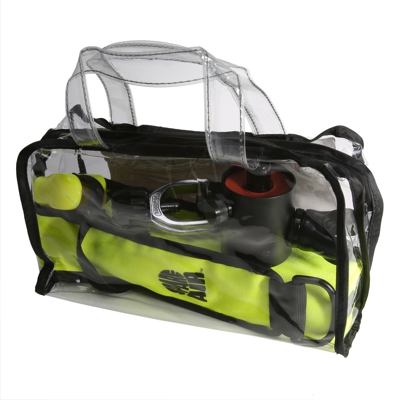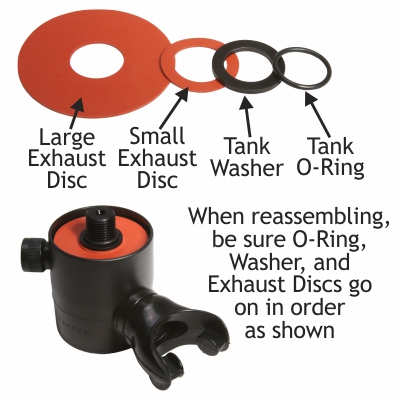Traveling with Spare Air
Spare Air is the ultimate travel buddy, especially when traveling to exotic destinations using rented or borrowed equipment.
When driving to your dive location, simply keep your Spare Air protected from dust and extreme temperatures like you would a regular SCUBA Tank and your dive equipment. The unit can travel fully charged, ready when you need it.
Flying is only a little more complicated. The war on terrorism has created greater travel restrictions. PLEASE BE AWARE OF THE FOLLOWING INFORMATION from the Transportation Security Administration (TSA):
"Except for personal medical oxygen cylinders, you can only carry an EMPTY compressed gas cylinder onboard a plane. To be permitted (in either carry-on or checked baggage), it must be clearly visible to the TSA officer that the cylinder is empty. Personal oxygen is permitted if the regulatory valve has not been tampered with or removed.
Unless being used for personal medical oxygen, the gas cylinder regulator valve must be completely disconnected from the cylinder (in other words, the cylinder has an open end that allows the TSO to visually inspect the cylinder). TSOs will NOT remove the seal or regulator valve from the cylinder. If the gas cylinder is sealed (the regulator valve is still attached) and not required for personal medical oxygen, the gas cylinder is prohibited, regardless of the reading on the pressure gauge indicator.
Source: https://www.tsa.gov, August 2017
YOU CAN FLY WITH YOUR SPARE AIR!
As mentioned above, your Spare Air must be depressurized and the regulator removed from the cylinder to allow for visual inspection. Follow these steps when packing for your trip.
- Empty all the air out of the SPARE AIR by pressing the Purge Button until no more air is released.
- Remove regulator from cylinder (regulator is attached hand tight) by turning counter clock-wise. Leave o-ring, washer etc. on the regulator. If the regulator does not unscrew easily DO NOT force it or use tools, instead soak the entire SPARE AIR in a 1-1 vinegar & water solution overnight to loosen any salt corrosion. Leave o-ring, washer and exhaust discs on the regulator.
- Place the SPARE AIR in a protective container (plastic bag or box) to keep unit clean and to secure loose parts. We recommend our optional accessory Travel Pack #963 for the 3 cu ft model, or the Travel Pack #966 for the larger 6 cu ft model. Both Travel Packs include a carry bag, dust caps, replacement tank o-rings 025 Combo and silicone lube (available online at ssishoppingcart.com).
- Pack SPARE AIR in your check or carry-on luggage.
- When you reach your dive destination, reassemble SPARE AIR and fill the cylinder. You may lightly lubricate the tank o-ring with a small amount of silicone spray or grease – never use a hydrocarbon based oil. DO NOT force regulator onto tank – if you feel resistance, stop, unscrew, and start again. [Note: Consult your Owner's Manual for correct installation order of exhaust discs, tank washer, and o-ring on regulator before attaching the cylinder.]
- Replace tank o-ring after product has been disassembled and reassembled 3 times, or o-ring shows signs of wear or air leakage. Tank o-ring size is 2-016 available online (027 set) or at any dive shop. A full set of replacement discs, tank washer and 0-ring are available as 025 Combo.
Tip from a Spare Air traveler:
"If you place your Spare Air in your carry-on bag, have your Spare Air cylinder and regulator exposed in a separate bin with the cylinder clearly empty with no cover. This way, TSA can quickly visually inspect the empty cylinder. This will prevent delays in the security line. After you have moved through security, cover the cylinder opening, return it to your carry-on bag, and wait until you arrive at your dive destination or home before reattaching the regulator to the cylinder. Don't forget your Owner's Manual to answer all your refilling and assembly questions."
"The Spare Air Travel Pack is a great accessory providing two caps to protect the treaded end regulator, keep dust out of the cylinder, and comes with a few extra o-rings, too! The regulator cap is great at keeping the Diaphragms, washer and o-ring in place."
Suggested Links:
• TSA website about traveling with your SCUBA equipment: It's Time to go Scuba Diving - Travel Tips for Divers (Friday, May 18, 2012)
• List of Permitted and Prohibited Items by the TSA.


INFO
© 2025 Submersible Systems, Inc. all rights reserved. "Spare Air" is a registered trademark of Submersible Systems.
ISO 9001:2015 Certified
Banners Images by Benja Iglisis









